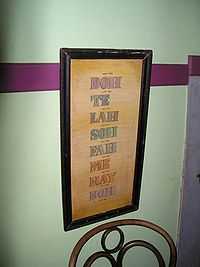Tonic sol-fa

Tonic sol-fa (or Tonic sol-fah) is a pedagogical technique for teaching sight-singing, invented by Sarah Ann Glover (1785–1867) of Norwich, England and popularised by John Curwen who adapted it from a number of earlier musical systems. It uses a system of musical notation based on movable do solfège, whereby every tone is given a name according to its relationship with other tones in the key: the usual staff notation is replaced with anglicized solfège syllables (e.g. do, re, mi, fa, sol, la, ti, do) or their abbreviations (d,r,m,f,s,l,t,d). "Do" is chosen to be the tonic of whatever key is being used (thus the terminology moveable Do). The original Solfege sequence started with "Ut" which later became "Do".
By the end of the nineteenth century, this notation was very widespread in Britain, and it became standard practice to sell sheet music (for popular songs) with the tonic sol-fa notation included.
Some of the roots of tonic sol-fa may be found in items such as
- the use of syllables in the 11th century by the monk Guido de Arezzo
- the cipher notation proposed by Jean-Jacques Rousseau in France in 1746,
- its further development by Pierre Galin and popularization by Aimé Paris and Emile Chevé, and
- the Norwich sol-fa of Sarah Ann Glover of England. Reverend John Curwen (1816–1880) was instrumental in the development of tonic sol-fa in England, and was chiefly responsible for its popularity.
 Depiction of Curwen's Solfege hand signs. This version includes the tonal tendencies and interesting titles for each tone.
Depiction of Curwen's Solfege hand signs. This version includes the tonal tendencies and interesting titles for each tone.
When John Windet printed the 1594 edition of the Sternhold and Hopkins Psalter, he added the initials of the six syllables of Guido (U, R, M, F, S, L) underneath the note. Windet explained, "...I have caused a new print of note to be made with letter to be joined to every note: whereby thou mayest know how to call every note by his right name, so that with a very little diligence thou mayest more easilie by the viewing of these letters, come to the knowledge of perfect solfeying..." Rousseau, Curwen and others would have been aware of this popular psalter.
B. C. Unseld and Theodore F. Seward, with Biglow and Main publishers, imported Curwen's tonic sol-fa to the United States, though the method was never widely received. Prior to this, the 9th edition of the Bay Psalm Book (Boston, USA) had appeared with the initials of four-note syllables (fa, sol, la, me) underneath the staff. Reverend John Tufts, in his An Introduction to the Singing of Psalm Tunes in a Plaine & Easy Method, moved the initials of the four-note syllables onto the staff in place of "regular notes", and indicated rhythm by punctuation marks to the right of the letters. These may be considered American forerunners of Curwen's system, though he may not have been aware of them. Tufts' Introduction was popular, going through several editions. Nevertheless, his work probably did more to pave the way for shape notes. When Unseld and Steward introduced tonic sol-fa in the late 1800s, it was considered "something new".
In 1972 Roberto Goitre printed one of the most important modern versions of the method in Cantar Leggendo with the moveable Do.
Solmization that represents the functions of pitches (such as tonic sol-fa) is called "functional" solmization. All musicians that use functional solmization use "do" to represent the tonic (also known as the "keynote") in the major mode. However, approaches to the minor mode fall into two camps. Some musicians use "do" to represent the tonic in minor (a parallel approach), whereas others prefer to label the tonic in minor as "la" (a relative approach) Both systems have their advantages: The former system more directly represents the scale-degree functions of the pitches in a key; the latter more directly represents the intervals between pitches in any given key signature.
Examples
- The beginning of the "Conversation" towards the end of the Steven Spielberg motion picture Close Encounters of the Third Kind uses both verbal and hand signals.
References
- The Teacher's Manual of the Tonic Sol-fa Method: Dealing with the Art of Teaching and the Teaching of Music, by John Curwen ISBN 0-86314-118-8